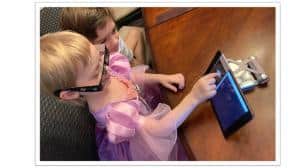Wearing polarizing glasses and playing the brightness test "Lazy Eye" can be detected in children as young as 3 years old solely through pl
"Lazy Eye" can be detected in children as young as 3 years old solely through playing a game on a mobile device.
MIAMI BEACH, FL, USA, December 28, 2021 /EINPresswire.com/ — Imagine, Vision Testing while Kids Play Fun iPad Games
Among the technological advances sweeping the digital world, the DiagnosticGame iOS app, a new and revolutionary approach for vision screening, has been reported to accurately and easily detect children afflicted with Amblyopia. Appearing in the Royal College of Ophthalmologists Nature/Eye Journal in open access (https://www.nature.com/articles/s41433-021-01862-x.pdf) is the article, "Screening Children using a Mobile Graphic Device", authored by Steven A. Kane, Mark Gaspich, Julia Kane, Sarah A. Weitzman, and Albert Hofeldt from Columbia University and New York Eye and Ear Infirmary of Mt. Sinai. This is the first report of measuring brightness balance in children. According to Pediatric Ophthalmologist, Steven A. Kane, MD, PhD, brightness balance, acuity and color vision can be measured in children as young as 3 years old solely by playing a fun and easy game on a mobile device. Testing times were brief and children enjoyed playing games on a mobile graphic device while their vision was being analyzed. The DiagnosticGame app detects Amblyopia by two methods: visual acuity and brightness balance. Brightness imbalance is the key determinant of Amblyopia. According to Dr. Kane, " Interocular brightness disparity is a sensitive and specific method to detect unilateral amblyopia".
According to the Centers for Disease Control and Prevention (CDC), Amblyopia, also referred to as “lazy eye”, is the most common cause of vision impairment in children. This elusive condition occurs in up to 6.2% of populations and fortunately when detected early is treatable. Over the years, screening devices and vision screening programs in schools and doctors' offices have not significantly altered the incidence of this childhood affliction. This raises the question, "Is the permanent vision loss from lazy eye due to inadequate detection or inadequate treatment?" In a pooled literature review in 1998 treatment success was achieved in the majority (74.3%) of lazy eye patients; therefore, detection is critical so that treatment can be started early to reverse the vision loss from lazy eye.
The DiagnosticGame iOS mobile app is currently the only available method for measuring brightness balance. It is obtainable as a free download from the Apple Store and consumable games are charged at Apple's minimum price. Disposable accessories are available from AMA Optics, Inc. at www.DiagnosticGame.com. Specialized, expensive equipment is not needed for testing, making this methodology potentially attractive for online vision screening and telemedicine. This at-home test requires an adult to assist the child in setting up and beginning the test, but once it is initiated, children find it incredibly easy to play. Video games, Smartphones and Tablets are ubiquitous among many societies and very popular with children. Albert Hofeldt, MD, the developer of the DiagnosticGame app, envisions telemedicine reaching the child next door and children in remote areas as they play games on mobile devices that precisely measure their visual function. Remote in-depth vision testing with internet transfer of results is now possible and could be the long-awaited discovery needed for removing lazy eye as the most common cause of permanent vision impairment in children.
Albert Hofeldt, MD
AMA Optics, Inc.
+1 305-389-0928
ajh@amaoptics.com
![]()
